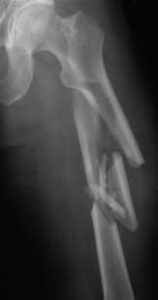 Comminuted fractures are a type of broken bone.
Comminuted fractures are a type of broken bone.
The term comminuted fracture refers to a bone that is broken in at least two places.
Comminuted fractures are caused by severe traumas.
These fractures can affect any large or long bone in your body.
Some of the most common include:
Femur
Tibia
Fibula
Humerus
Radius and ulna
Clavicle
Skull.
Comminuted fractures are almost always caused by serious traumas like car accidents or falls from a high place.
Comminuted fractures are very serious in large bones.
Commuted fractures are a specific type of bone fracture where the bone breaks into multiple pieces, often resulting in a shattered or fragmented appearance.
These types of fractures can be quite serious and difficult to treat, as the multiple bone fragments can make it challenging for the bone to heal properly.
Treatment for a communuted fracture usually involves immobilizing the affected limb, realigning the bone fragments, and possibly surgery to hold the pieces of bone in place while they heal.
Delaying treatment can lead to further complications.
Sometimes, comminuted fractures in smaller bones can heal without surgery.
Most people need up to a year to recover from a comminuted fracture if it involved one of the long or larger bones, especially if it requires surgery.
Segmental fractures happen when a bone is broken in two different places and a section of the bone has separated from the rest of the bone because of the fracture.
Some segmental fractures are comminuted, and some are not.
A displaced fracture means the pieces of th bone moved so much that a gap formed around the fracture when the bone broke.
Non-displaced fractures are still broken bones, but the pieces weren’t moved far enough to be out of alignment during the break.
Displaced fractures are much more likely to require surgery to repair.
Comminuted fractures are more likely to be displaced than other types of broken bones because they always have multiple broken pieces.
Any impact to your bones can cause a comminuted fracture, but slips, falls and other common causes of broken bones aren’t usually strong enough damage to bones enough to cause a comminuted fracture.
X-rays: An X-ray will confirm any comminuted or other fractures.
Magnetic Resonance Imaging (MRI), and CT scan allow for a more complete picture of the damage to the bones and the area around them to determine how the muscles, connective tissue and organs were affected by the trauma.
Surgery is needed to repair a comminuted fracture if a long or large bone is broken.
The surgeon corrects the bones positions and then secures them in place so they can heal and grow back together.
Internal fixation, with the insertion pieces of metal into your bone to hold it in place while it heals.
Internal fixation techniques include:
Rods: A rod inserted through the center of the bone that runs from top-to-bottom.
Plates and screws: Metal plates screwed into the bone to hold them in place.
Pins and wires: Pins and wires hold pieces of bone in place that are too small for other fasteners, are typically be used at the same time as either rods or plates.
External fixation is often a temporary solution that stabilizes your fracture while your other injuries heal.
Screws are placed on either side of the fracture then connected to a brace or bracket around the bone outside the body.
Surgeons sometimes recommend external fixation as a first step before more invasive surgeries to fix a comminuted fracture.
Bone grafting may be necessary if the comminuted fracture is severely displaced.
After your surgery, the fractured bone in it will be immobilized, with some combination of a brace, splint or cast before putting any weight on it.
What medications are used to treat comminuted fractures?
Comminuted fracture surgery complications include:
Acute compartment syndrome (ACS)
Malunion
Nonunion
Osteomyelitis.
Other internal damage: to muscles, nerves, blood vessels, tendons and ligaments.
